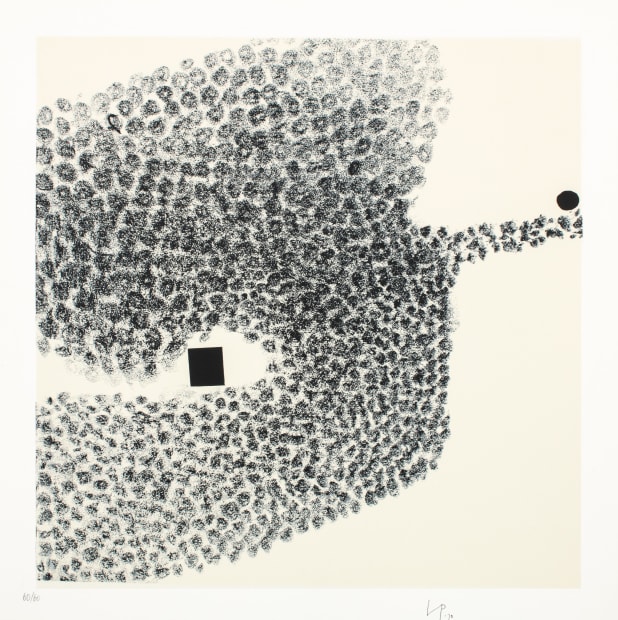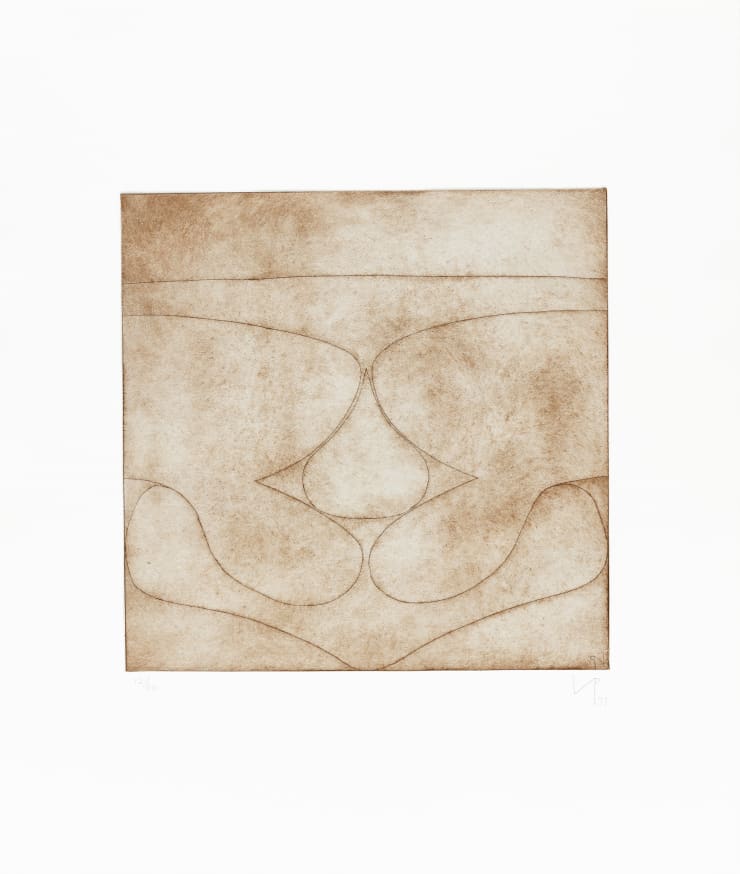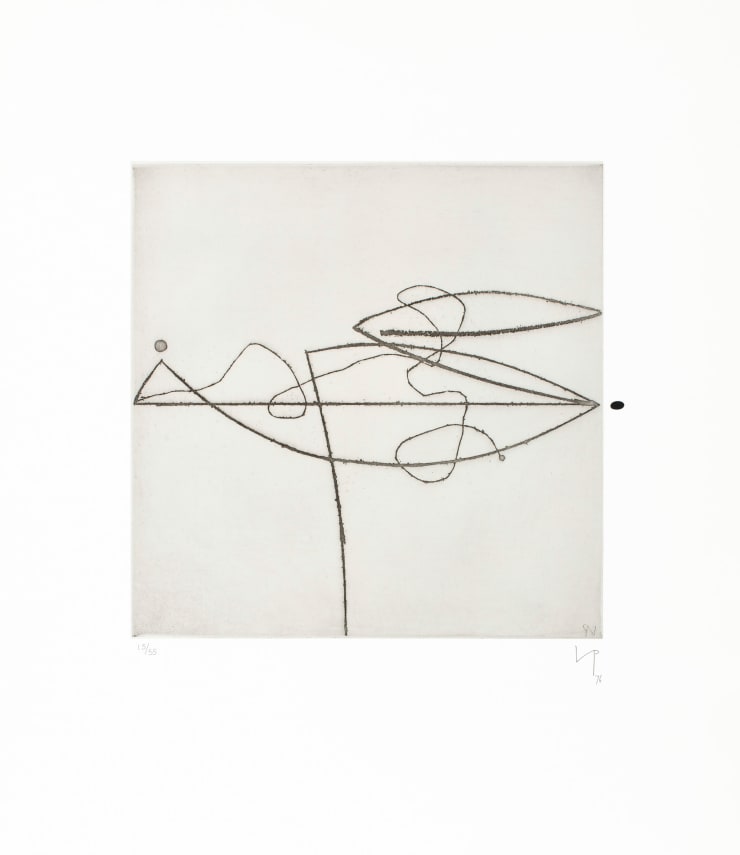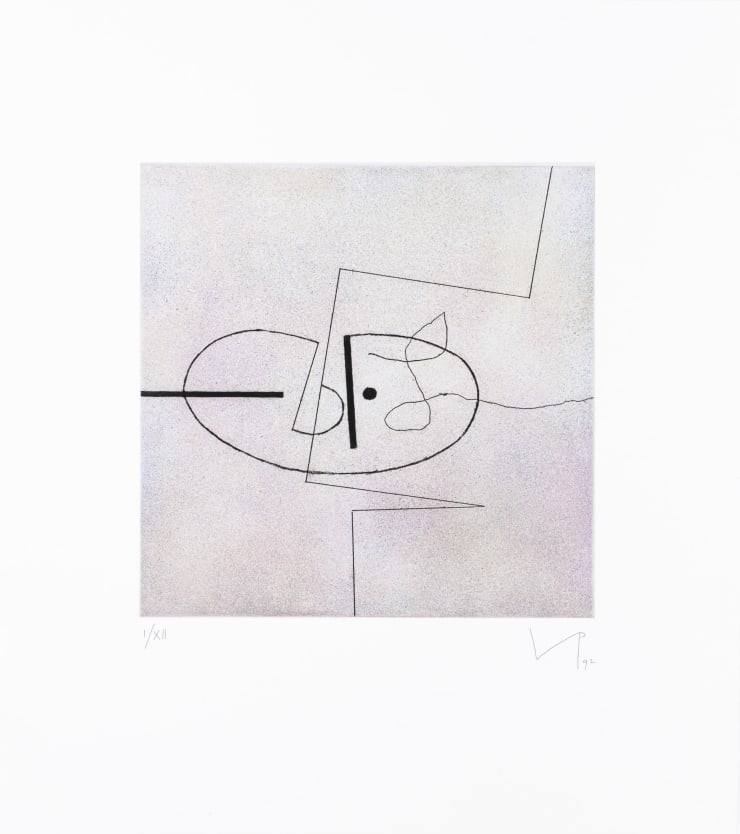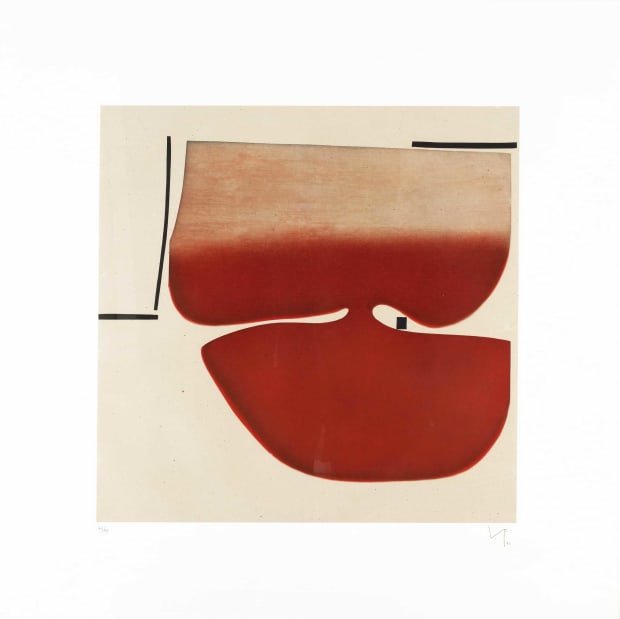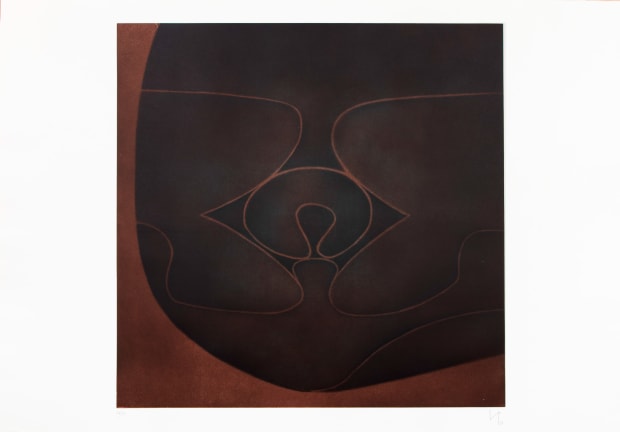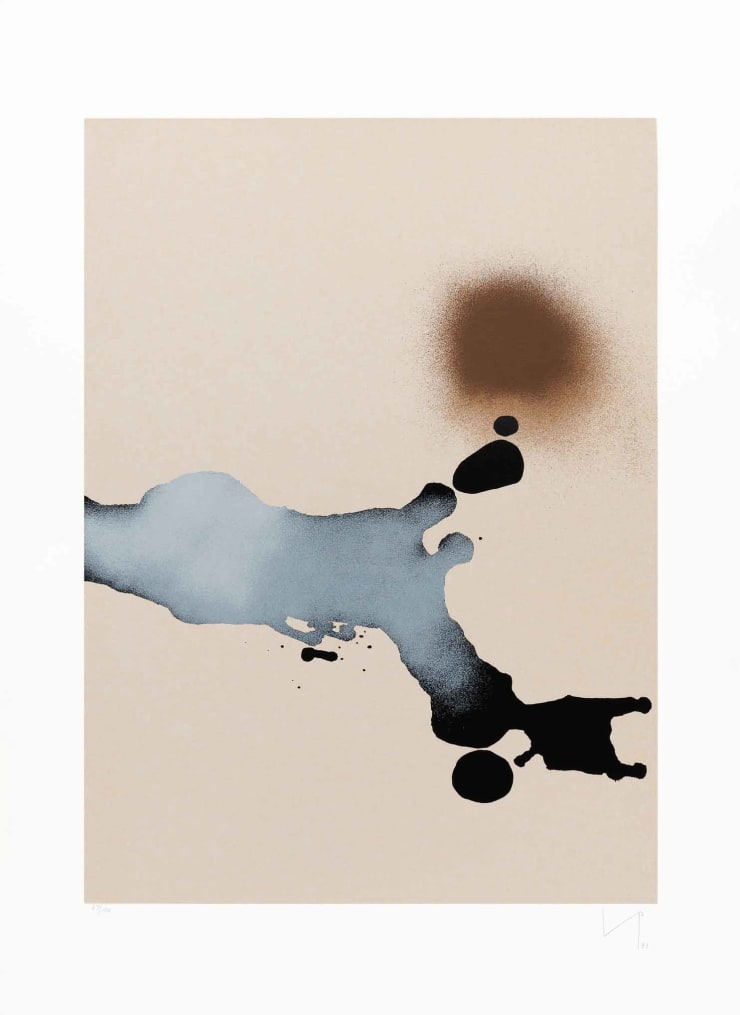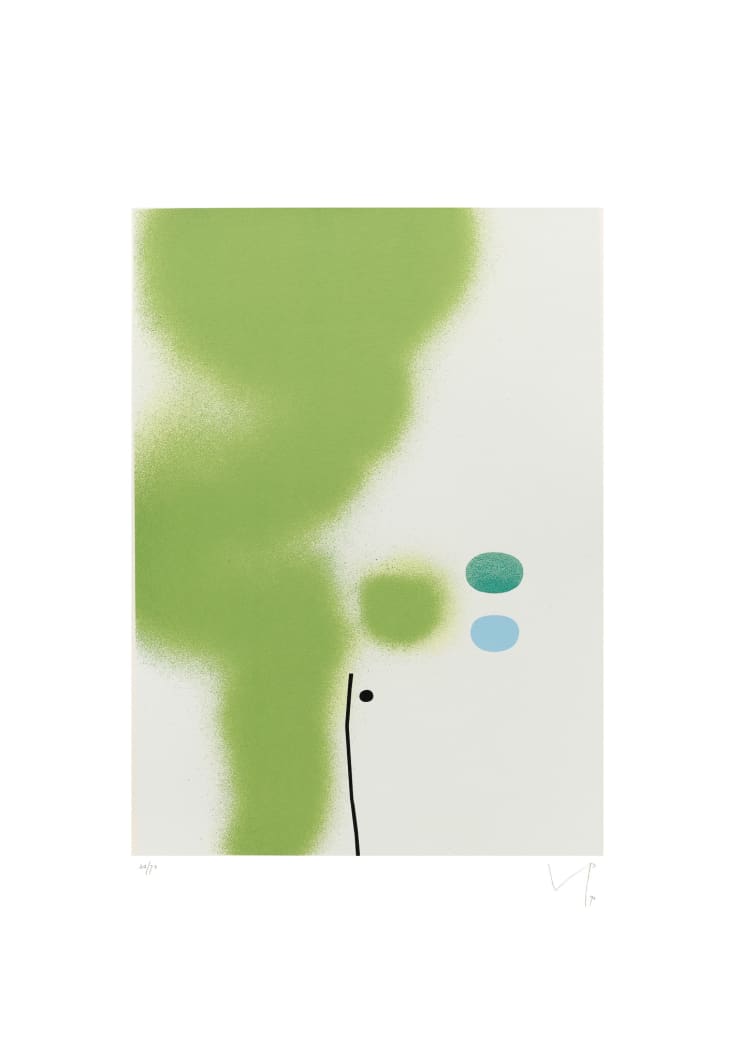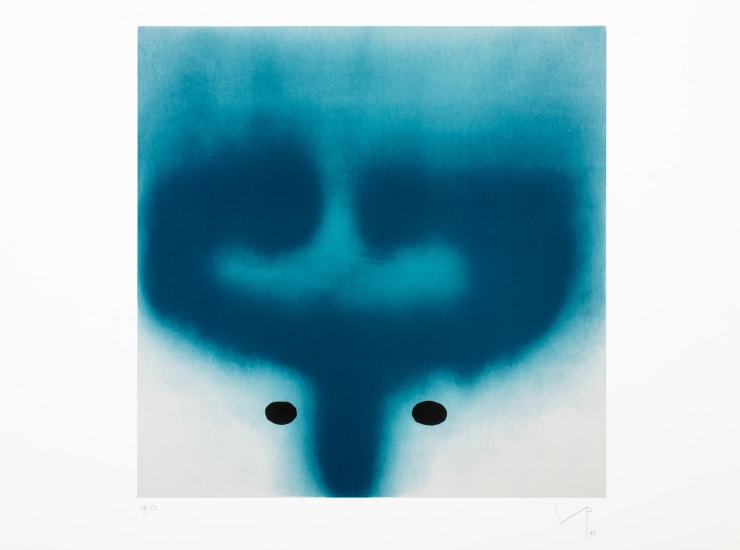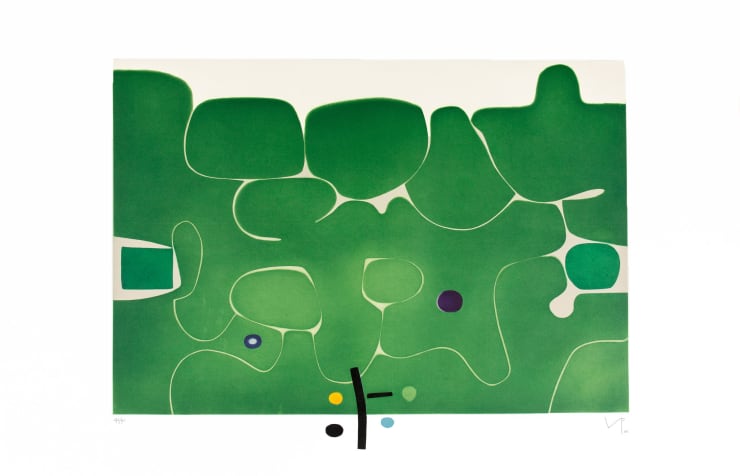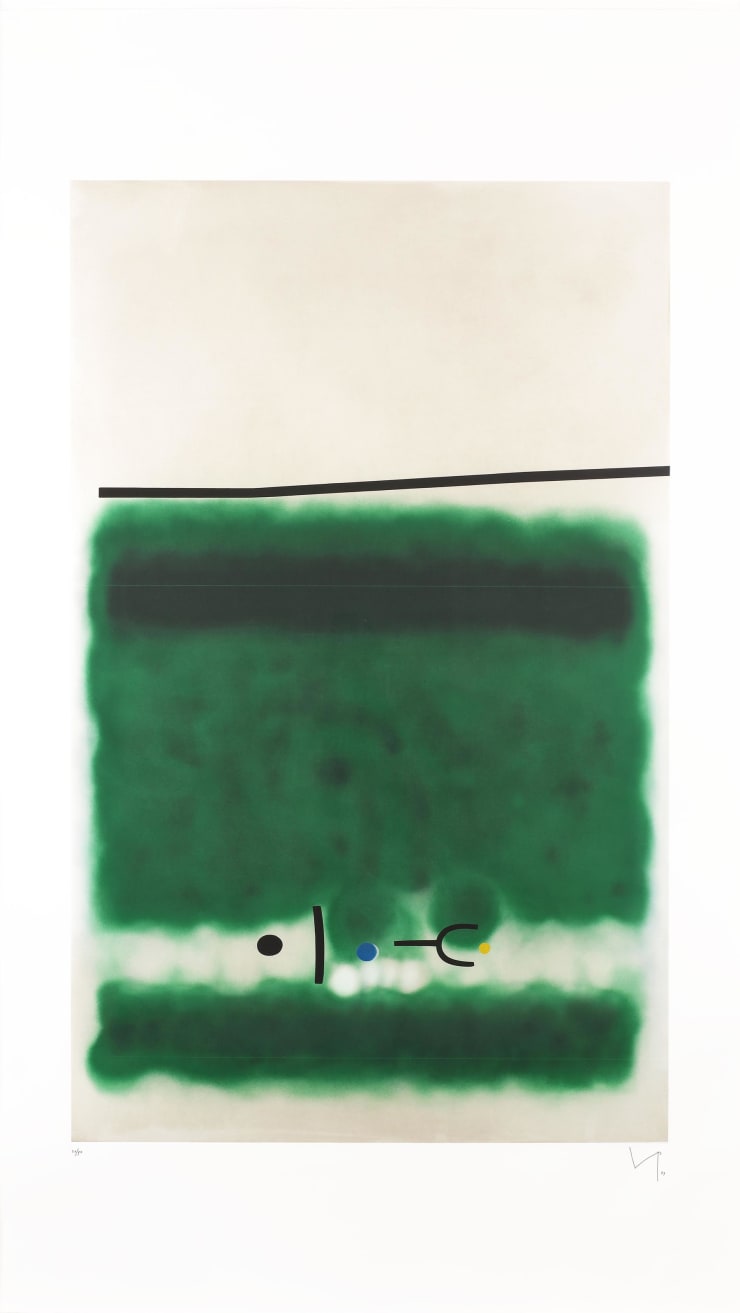-
 'Points of Contact No. 35', 1981, screenprint on paper
'Points of Contact No. 35', 1981, screenprint on paper -
Victor Pasmore’s exhibition at the Redfern Gallery in 1948 saw his transformation from a leading exponent of English realism to standard bearer for a rigorous uncompromising abstraction. This was hailed as ‘the most revolutionary moment in post-war British Art’ by critic and historian Herbert Read and it earned Pasmore admiration and antagonism in equal measure. Pasmore called for a re-engagement with the international modernism of the 1930s in order to create a formal language for a new post-war age shaken by a spirit of reconstruction. Based on a return to first principles of geometry, mathematics, and science, this found expression in Pasmore’s paintings and wall reliefs of the 1950s and early 1960s with their severe forms and limited colour palette. While this may have been expected from the recently converted ‘hair-shirt prophet’ of abstraction, this may come as a surprise to a visitor to the gallery for this show where graceful forms and lyrical colour characterise the majority of works on display.
This show is witness to an endlessly compelling and hugely significant figure in post-war British art. Pasmore sought to give voice to a new age with a sustained exploration of line, colour and harmony. His embrace of graphic media and the collaborations that this entailed are of pivotal importance and gave fresh impetus to this project. The result is a ravishing testament to the possibilities of print.
- Vincent Eames, 2023
Read the full essay at the bottom of this page
-

-
-
 Victor PasmoreThe Cave of Calypso III, 1977Sold
Victor PasmoreThe Cave of Calypso III, 1977Sold -
 Victor PasmoreThe Cave of Calypso IV, 1977Sold
Victor PasmoreThe Cave of Calypso IV, 1977Sold -
 Victor PasmoreMetamorphosis (Linear Motifs) 5, 1976Sold
Victor PasmoreMetamorphosis (Linear Motifs) 5, 1976Sold -
 Victor PasmoreImages on the Wall Print G (version A), 1991-92Sold
Victor PasmoreImages on the Wall Print G (version A), 1991-92Sold -
 Victor PasmoreImages on the Wall Print B, 1991-92Sold
Victor PasmoreImages on the Wall Print B, 1991-92Sold -
 Victor PasmoreImages on the Wall Print F (Version A), 1991-92Sold
Victor PasmoreImages on the Wall Print F (Version A), 1991-92Sold -
 Victor PasmoreImages on the Wall Print H (version B), 1991-92Sold
Victor PasmoreImages on the Wall Print H (version B), 1991-92Sold
-
-

-

-
-
 Victor PasmorePoints of Contact No. 35, 1981Sold
Victor PasmorePoints of Contact No. 35, 1981Sold -
 Victor PasmorePunto di Contatto 1, 1982Sold
Victor PasmorePunto di Contatto 1, 1982Sold -
 Victor PasmoreBurning Water, 1984Sold
Victor PasmoreBurning Water, 1984Sold -
 Victor PasmoreThe Image in Search of Itself (I), 1977Framed£1,100.00
Victor PasmoreThe Image in Search of Itself (I), 1977Framed£1,100.00 -
 Victor PasmoreComposite Image: Orange and Pink, 1984Sold
Victor PasmoreComposite Image: Orange and Pink, 1984Sold -
 Victor PasmoreTwo Images (Blue), 1984Sold
Victor PasmoreTwo Images (Blue), 1984Sold
-
-

Victor Pasmore
Senza Titolo 12, 1992 -
Victor Pasmore, an introduction by Vincent Eames
It is a decade since we last hosted a selection of graphic work by Victor Pasmore in the Gallery and he makes a welcome return this summer. It is a timely return too as this continues a sequence of shows that we have conducted since the start of the year that examine different strands of 20th Century modernism. Henri Matisse's Line and Colour and Leon Kossoff's London Etchings provided contrasting contexts in the South of France and Willesden, while more recently, Paul Catherall's This Was Tomorrow explored the Brutalist heritage of Britain's post-war architecture and the utopianism that shaped it. The title of Paul's show is a decidedly rueful take on the era-defining Whitechapel Gallery show This is Tomorrow in 1956 that was a watershed moment in British art and architecture and the arena in which Pasmore further articulated the theories of abstraction that he had first introduced into his art nearly a decade earlier.
Pasmore's exhibition at the Redfern Gallery in 1948 saw his transformation from a leading exponent of English realism to standard bearer for a rigorous uncompromising abstraction. This was hailed as 'the most revolutionary moment in post-war British Art' by critic and historian Herbert Read and it earned Pasmore admiration and antagonism in equal measure.
Pasmore called for a re-engagement with the international modernism of the 1930s in order to create a formal language for a new post-war age shaken by a spirit of reconstruction. Based on a return to first principles of geometry, mathematics, and science, this found expression in Pasmore's paintings and wall reliefs of the 1950s and early 1960s with their severe forms and limited colour palette. While this may have been expected from the recently converted 'hair-shirt prophet' of abstraction, this may come as a surprise to a visitor to the gallery for this show where graceful forms and lyrical colour characterise the majority of works on display.
So how do we account for this apparent softening of emphasis? The change can be partly explained by location. Almost all of Pasmore's graphic work dates from after his move from London to Malta in 1966 and although he largely denied that it had a telling influence, his new Mediterranean environment is surely apparent in the vivid blues and greens that predominate in his graphic work from this point onwards. Pasmore did concede that life on the island had a liberating effect on his work by encouraging a spontaneous burst of printmaking. He sought out new opportunities for experimentation with Master Printmakers at Kelpra Studio and White Ink in the UK and 2RC in Rome. As we have seen with fellow abstract artists such as John Hoyland (see Relentless Rhythm : Prints from the 80s and 90s) and Barbara Hepworth, collaboration in the Studio setting with graphic technicians was hugely invigorating. Pasmore revelled in using large scale sheets of disposable paper in preparation for making his screenprints and described how composing in chalk and ink released 'new energies'.The unique potential of aquatint to combine the solidity of form with transparency of colour was particularly alluring.
Perhaps what printmaking gave Pasmore above all was a fresh process, a way of leavening the relentlessly objective approach of his painting, architecture and constructed reliefs with a medium that required a more collaborative, intuitive but still technically disciplined approach. Pasmore alluded to this obliquely when he credited life in Malta, with its close and constant proximity to the ancient, mythological and neolithic past, for orienting him away from the 'physics' of art towards its more biological and psychological content. Pasmore's deep exploration of print makes all the more sense in this context.
That Pasmore's move to Malta also coincided with his growing interest in surrealism and the metaphysical adds to a richer appreciation for his prints. In his earlier abstract phase, Pasmore had been suspicious of surrealism but by the 1960s he saw in it the potential to extend the boundaries of abstraction in order to prevent its descent into stylistic mannerism. The influence of Joan Miró was key to this embrace of the surrealist tendency. Pasmore was in regular correspondence with Miró during this period (and incidentally also owned a folio of Miró lithographs from Derrière le Miroir). As with Hoyland, Miró provided inspiration for Pasmore as he sought a route away from a more rigid formalism towards the fluid, lyrical approach of his later career. It is telling that this journey was marked by a flourishing in the graphic work of both artists.
This show is witness to an endlessly compelling and hugely significant figure in post-war British art. Pasmore sought to give voice to a new age with a sustained exploration of line, colour and harmony. His embrace of graphic media and the collaborations that this entailed are of pivotal importance and gave fresh impetus to this project. The result is a ravishing testament to the possibilities of print.
Victor Pasmore
Past viewing_room

